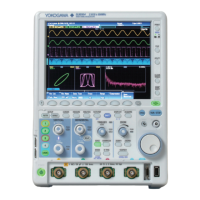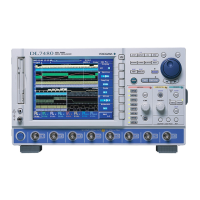2-58
IM DLM4038-02EN
2.18 Triggering on User-Defined Serial Bus Signals
This section explains the following settings (which are used when triggering on user-defined serial bus
signals).
• Bit rate
• Data source, clock source, chip select source, and latch source
Level used to detect source states
• Trigger condition
► “User-Defined Serial Bus Trigger [User Define, ENHANCED]” in the Features Guide
ENHANCED User Define Menu
Press ENHANCED and then the Type soft key. From the setup menu that appears, select User
Define. The menu that opens varies depending on whether the clock is on or off.
When the Clock Is Off
Set the trigger type to
User Define.
Turn the clock on or off (OFF).
Set the bit rate.
Set the trigger conditions.
Set the data source.
Set the data source (CH1 to CH8).
Set the data source state to be
recognized as 1 (H, L).
Set the level used to detect data
source states.
Set the trigger coupling, HF rejection,
and noise rejection.
► section 2.3
Setting the Data Source (Source)
Set the data source to compare with the pattern specified as a trigger condition.
Setting Trigger Conditions (Condition Setup)
Press the Condition Setup soft key to display the following screen.
You can use data patterns as trigger conditions. The data pattern trigger condition is met when the
sampled data source pattern matches the specified pattern.
Set the data pattern input format.
Set the data pattern.
The length of the data pattern you can enter is
determined by the Data Size setting. The
maximum data pattern length you can specify
is 128 bits.
Set the data length.
